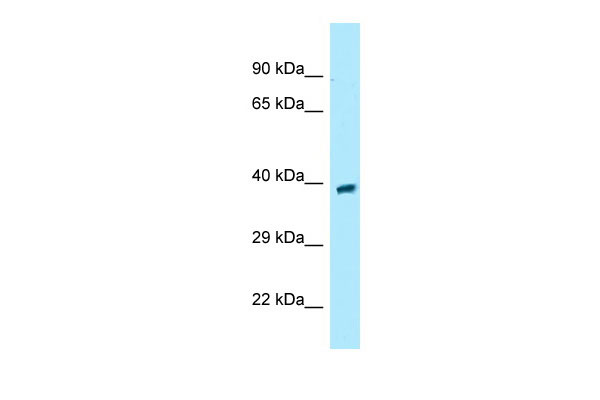GPR68 Antibody - middle region
Rabbit Polyclonal Antibody
- SPECIFICATION
- CITATIONS
- PROTOCOLS
- BACKGROUND

Application
| WB |
|---|---|
| Primary Accession | Q15743 |
| Other Accession | NM_003485, NP_003476 |
| Reactivity | Human, Mouse, Rat, Rabbit, Pig, Horse, Dog |
| Predicted | Human, Mouse, Rat, Rabbit, Pig, Horse, Dog |
| Host | Rabbit |
| Clonality | Polyclonal |
| Calculated MW | 41kDa |
| Gene ID | 8111 |
|---|---|
| Alias Symbol | MGC111379, MGC156983, OGR1, GPR12A |
| Other Names | Ovarian cancer G-protein coupled receptor 1, OGR-1, G-protein coupled receptor 68, GPR12A, Sphingosylphosphorylcholine receptor, GPR68, OGR1 |
| Format | Liquid. Purified antibody supplied in 1x PBS buffer with 0.09% (w/v) sodium azide and 2% sucrose. |
| Reconstitution & Storage | Add 50 ul of distilled water. Final anti-GPR68 antibody concentration is 1 mg/ml in PBS buffer with 2% sucrose. For longer periods of storage, store at 20°C. Avoid repeat freeze-thaw cycles. |
| Precautions | GPR68 Antibody - middle region is for research use only and not for use in diagnostic or therapeutic procedures. |
| Name | GPR68 {ECO:0000303|PubMed:27693231, ECO:0000312|HGNC:HGNC:4519} |
|---|---|
| Function | Proton-sensing G-protein coupled receptor activated by extracellular pH, which is required to monitor pH changes and generate adaptive reactions (PubMed:12955148, PubMed:29677517, PubMed:32865988, PubMed:33478938, PubMed:39753132). The receptor is almost silent at pH 7.8 but fully activated at pH 6.8 (PubMed:12955148, PubMed:39753132). Ligand binding causes a conformation change that triggers signaling via guanine nucleotide-binding proteins (G proteins) and modulates the activity of downstream effectors, such as phospholipase C (PubMed:29677517, PubMed:39753132). GPR68 is mainly coupled to G(q) G proteins and mediates production of diacylglycerol (DAG) and inositol 1,4,5-trisphosphate (IP3) (PubMed:29677517, PubMed:39753132). Acts as a key mechanosensor of fluid shear stress and membrane stretch (PubMed:29677517, PubMed:30471999). Expressed in endothelial cells of small-diameter resistance arteries, where it mediates flow-induced dilation in response to shear stress (PubMed:29677517). May represents an osteoblastic pH sensor regulating cell-mediated responses to acidosis in bone (By similarity). Acts as a regulator of calcium- sensing receptor CASR in a seesaw manner: GPR68-mediated signaling inhibits CASR signaling in response to protons, while CASR inhibits GPR68 in presence of extracellular calcium (By similarity). |
| Cellular Location | Cell membrane; Multi-pass membrane protein |
| Tissue Location | Found at low level in a wide range of tissues, but significantly expressed in lung, kidney, bone and nervous system |

Thousands of laboratories across the world have published research that depended on the performance of antibodies from Abcepta to advance their research. Check out links to articles that cite our products in major peer-reviewed journals, organized by research category.
info@abcepta.com, and receive a free "I Love Antibodies" mug.
Provided below are standard protocols that you may find useful for product applications.
References
An S.,et al.FEBS Lett. 375:121-124(1995).
Xu Y.,et al.Genomics 35:397-402(1996).
Kaighin V.A.,et al.Submitted (JUL-2008) to the EMBL/GenBank/DDBJ databases.
King M.M.,et al.Submitted (APR-2004) to the EMBL/GenBank/DDBJ databases.
Heilig R.,et al.Nature 421:601-607(2003).
If you have used an Abcepta product and would like to share how it has performed, please click on the "Submit Review" button and provide the requested information. Our staff will examine and post your review and contact you if needed.
If you have any additional inquiries please email technical services at tech@abcepta.com.













 Foundational characteristics of cancer include proliferation, angiogenesis, migration, evasion of apoptosis, and cellular immortality. Find key markers for these cellular processes and antibodies to detect them.
Foundational characteristics of cancer include proliferation, angiogenesis, migration, evasion of apoptosis, and cellular immortality. Find key markers for these cellular processes and antibodies to detect them. The SUMOplot™ Analysis Program predicts and scores sumoylation sites in your protein. SUMOylation is a post-translational modification involved in various cellular processes, such as nuclear-cytosolic transport, transcriptional regulation, apoptosis, protein stability, response to stress, and progression through the cell cycle.
The SUMOplot™ Analysis Program predicts and scores sumoylation sites in your protein. SUMOylation is a post-translational modification involved in various cellular processes, such as nuclear-cytosolic transport, transcriptional regulation, apoptosis, protein stability, response to stress, and progression through the cell cycle. The Autophagy Receptor Motif Plotter predicts and scores autophagy receptor binding sites in your protein. Identifying proteins connected to this pathway is critical to understanding the role of autophagy in physiological as well as pathological processes such as development, differentiation, neurodegenerative diseases, stress, infection, and cancer.
The Autophagy Receptor Motif Plotter predicts and scores autophagy receptor binding sites in your protein. Identifying proteins connected to this pathway is critical to understanding the role of autophagy in physiological as well as pathological processes such as development, differentiation, neurodegenerative diseases, stress, infection, and cancer.


